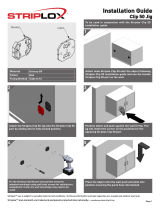
PAGE 12 LINN SONDEK LP12 SET-UP MANUAL
45) Turn on the turntable, while observing the position of the belt. The belt should drop down to the
bottom of the pulley when the table is turned on, and ride up to the center position on the pulley, where it
just reaches its full diameter once the table is up to speed (refer to "Belt Height Adjustment" diagram). On
new tables, this adjustment is set from the factory, and probably will not require adjusting. However, if the
belt should fail to drop down on start up, the motor tilt needs to be adjusted. This is accomplished by
FIRST LOOSENING the motor tilt adjusting screw nearest the inner platter, and then tightening the outer
screw, which will tilt the motor out, making it easier for the belt to run down on start up. Conversely, if the
belt fails to ride up, the motor can be tilted in by FIRST LOOSENING the outer screw, then tightening the
inner one. Once the correct belt position has been achieved, or assuming it as correct originally, see to it
that both motor screws are actually turned down so that they are touching the motor casing. THESE
SCREWS SHOULD BE SNUG ONLY! FURTHER TIGHTENING WILL SIMPLY BEND THE CASE OF
THE MOTOR, AND RENDER FURTHER ADJUSTMENT IMPOSSIBLE!
When the belt drops to the bottom of the pulley, the bottom edge of the belt should
scrape against the metal belt guide that is attached to the stainless steel top plate.
This helps remove any static build-up from the belt. If the belt is dropping to the
bottom of the pulley but does not touch the belt guide, the entire motor must be
lowered relative to the top plate. This is most easily accomplished by simply tightening
both tilt adjustment screws and intentionally forcing the motor down. This should be
done very carefully, checking your progress after each half turn of the screws. After
this operation is completed, double-check the action of the belt upon turn-on and
readjust the pulley tilt if necessary.
46) At this time, the adjustment of the turntable should be complete. It is normal for the motor to
make a very soft ticking sound if you listen close to the table. However, occasionally one will encounter a
motor that makes an excessively loud ticking or scraping noise. If this is the case, the problem is with the
adjustment of the bottom bearings of the motor, and not with the motor itself. UNPLUG THE TABLE
FROM THE A/C POWER. Remove the bottom panel. Pop off the bearing cap on the bottom of the
motor (refer to the "Motor Mounting Diagram"). It is a force fit, and simply pulls off with your hand. Check
to see that the thrust pad on the bottom of the motor shaft is squarely seated, and does not wobble as
you turn the motor shaft. If it does, you can remove it by popping it off with your fingernail, and reseat it
squarely by pushing it back on. If this is square, check to see that the spring and thrust bearing assembly
are seated all the way down in the cap. You can press it down with the eraser end of a pencil to seat it.
Re-lubricate the top of the thrust bearing with a dab of light grease (or petroleum jelly [Vaseline] if nothing
else is available) before popping the cap back on the motor. Be careful not to get any grease on the
edges of the cap, since it is a friction fit. After popping the cap back on, push down on the motor pulley
from above. The pulley should push down, then spring back up to its original position when you let go. If
you dislodge the cap when you push down on the motor pulley, you have not correctly seated the spring
in the cap.
12
























